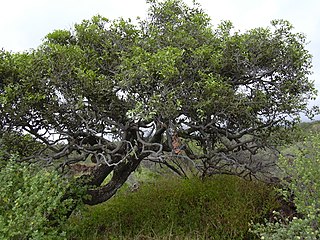
The Ebenaceae are a family of flowering plants belonging to order Ericales. The family includes ebony and persimmon among about 768 species of trees and shrubs. It is distributed across the tropical and warmer temperate regions of the world. It is most diverse in the rainforests of Malesia, India, tropical Africa and tropical America.
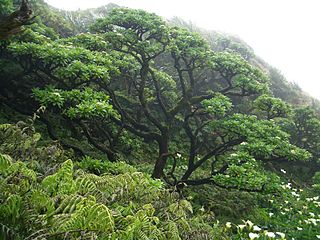
The Saint Helena scrub and woodlands ecoregion covers the volcanic island of Saint Helena in the South Atlantic Ocean. The island's remote location gave rise to many endemic species. First discovered and settled in the 1500s, the island has been degraded by human activities. Most of its native habitat has been destroyed, and many of its unique plants and animals are extinct or endangered.
Ebony is a dense black hardwood.

The Saint Helena olive is an extinct species of flowering plant. It is the only member of the genus Nesiota. It was endemic to the island of Saint Helena in the South Atlantic Ocean. Despite its name, it is unrelated to the true olive, but is instead a member of the family Rhamnaceae, the family which contains buckthorns and jujube. The last remaining tree in the wild died in 1994, and the last remaining individual in cultivation died in December 2003, despite conservation efforts. It is thus a prime example of recent plant extinction. The Saint Helena olive belongs to the tribe Phyliceae, which are mostly endemic to Southern Africa.

The flora of Saint Helena, an isolated island in the South Atlantic Ocean, is exceptional in its high level of endemism and the severe threats facing the survival of the flora. In phytogeography, it is in the phytochorion St. Helena and Ascension Region of the African Subkingdom, in the Paleotropical Kingdom.

Trochetiopsis erythroxylon, the Saint Helena redwood, is a species of plant, now extinct in the wild. It was formerly abundant enough in the upland parts of the island of Saint Helena for early settlers in the 17th century to use the timber to make their homes. It now exists in cultivation, although cultivated stock is weak. This species has pendant flowers, petals that turn pink with age, and white staminodes.

Trochetiopsis ebenus, the dwarf ebony or Saint Helena ebony, is a species of flowering plant that is endemic to the island of Saint Helena in the southern Atlantic Ocean. It is not related to the ebony of commerce, but is instead a member of the mallow family, Malvaceae. Saint Helena ebony is now critically endangered in the wild, being reduced to two wild individuals on a cliff, but old roots are sometimes found washed out of eroding slopes. These are collected on the island a used for inlay work, an important craft on Saint Helena. A related species, Trochetiopsis melanoxylon is now completely extinct.
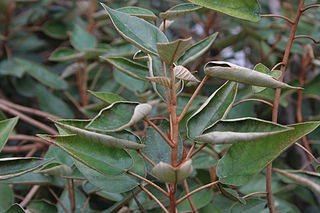
The flowering plant genus Trochetiopsis consists of two extant and one extinct species endemic to the island of Saint Helena. They were formerly placed in the family Sterculiaceae, but this is included in the expanded Malvaceae in the APG and most subsequent systematics.
Banksia biterax is a species of dense shrub that is endemic to Western Australia. It has hairy stems, deeply serrated leaves and spikes of up to 200 pale to dark brown flowers.
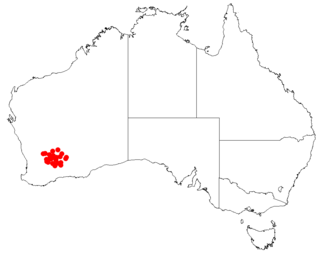
Persoonia inconspicua is a species of flowering plant in the family Proteaceae and is endemic to the south-west of Western Australia. It is an erect, often spreading shrub with branchlets and leaves that are densely hairy when young, linear leaves and relatively small greenish yellow flowers usually borne singly or in pairs.

Calothamnus hirsutus is a plant in the myrtle family, Myrtaceae and is endemic to the south-west of Western Australia. It is a small, spreading shrub with prominent hairs on the leaves giving them a smoky appearance. The flowers are deep red and are usually in dense clusters between the older leaves.
St Helena ebony is a common name for two closely related plants endemic to St Helena. It is inconsistently applied, and either of the following species may be referred to as St Helena ebony, with dwarf ebony used to refer to the other:
Dwarf ebony is a common name for two closely related plants endemic to St Helena. It is inconsistently applied, and either of the following species may be referred to as dwarf ebony, with St Helena ebony used to refer to the other:
Pseuduvaria calliura is a species of plant in the family Annonaceae. It is endemic to Borneo. Herbert Kenneth Airy Shaw, the English botanist who first formally described the species, named it after the long, beautiful tails, or tips, of its leaves.
Pseuduvaria dielsiana is a species of plant in the family Annonaceae. It is native to New Guinea. Carl Lauterbach, the German botanist who first formally described the species using the synonym Goniothalamus dielsianus, named it in honor of Ludwig Diels, another German botanist who also worked on taxa from New Guinea.
Pseuduvaria grandifolia is a species of plant in the family Annonaceae. It is native to New Guinea. Otto Warburg, the German-Jewish botanists who first formally described the species using the basionym Stelechocarpus grandifolius, named it after its large leaves.
Pseuduvaria mollis is a species of plant in the family Annonaceae. It is native to New Guinea. Otto Warburg, the German-Jewish botanists who first formally described the species using the basionym Goniothalamus mollis, named it after the soft hairs on its leaves and petals.
Pseuduvaria oxycarpa is a species of plant in the family Annonaceae. It is native to Sulawesi. Sijfert Hendrik Koorders, the Dutch botanist who first formally described the species, named it after the pointed tips of its fruit.

Pseuduvaria reticulata is a species of plant in the family Annonaceae. It is native to Bangladesh, Borneo, Java, the Lesser Sunda Islands, Myanmar and Sumatra. Carl Ludwig Blume, the botanist who first formally described the species under the basionym Uvaria reticulata, named it after the net-like pattern of veins on the underside of its leaves.
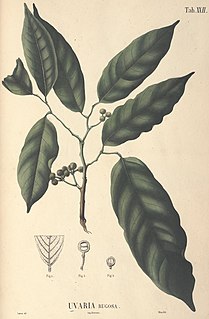
Pseuduvaria rugosa is a species of plant in the family Annonaceae. It is native to Java, Laos, the Lesser Sunda Islands, Peninsular Malaysia, Myanmar, the Nicobar Islands, Sumatra and Thailand. Carl Ludwig Blume, the botanist who first formally described the species under the basionym Uvaria rugosa, named it after its wrinkled fruit.











